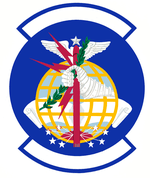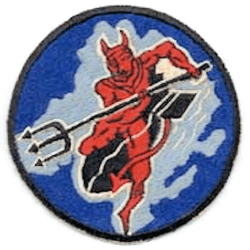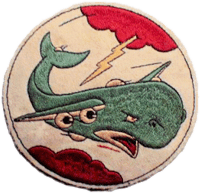330th Combat Training Squadron
330th Combat Training Squadron
 | |
|---|---|
|
An airborne radar technician instructor with the 330th Combat Training Squadron evaluates a student during pre-flight checks on an E-8C Joint STARS at Robins AFB | |
| Active | 1942–1963; 1988–1994; 2002–present |
| Country |
|
| Branch |
|
| Role | Aircrew training |
| Part of | Air Combat Command |
| Garrison/HQ | Robins Air Force Base |
| Engagements |
European Theater of Operations Mediterranean Theater of Operations[1] |
| Decorations |
Distinguished Unit Citation Air Force Outstanding Unit Award[1] |
| Insignia | |
| 330th Combat Training Squadron emblem (approved 12 May 1989)[1] |
 |
| 330th Bombardment Squadron emblem (SAC era) |
 |
| 330th Bombardment Squadron emblem (World War II)[2] |
 |
The 330th Combat Training Squadron was a United States Air Force unit assigned to the 461st Air Control Wing based at Robins Air Force Base, Georgia.
History
World War II
Established in early 1942 initially as a Consolidated B-24 Liberator reconnaissance squadron, flying antisubmarine patrols. Later trained under Third Air Force in Florida. Completed training in late 1942; deploying to European Theater of Operations as one of the initial heavy bomber squadrons assigned to VIII Bomber Command in England, September 1942.
Engaged in long-range strategic bombardment operations over Occupied Europe. Deployed to IX Bomber Command in Egypt in December 1942; operating from airfields in Libya and Tunisia. Raided enemy military and industrial targets in Italy and in the southern Balkans, including the Nazi-controlled oilfields at Ploesti, Romania, receiving a Distinguished Unit Citation for its gallantry in that raid. Also flew tactical bombing raids against Afrika Korps defensive positions in Tunisia; supporting British Eighth Army forces in their advance to Tunis, in September and October 1943.
Returned to England with disestablishment of IX Bomber Command in North Africa. From England, resumed long-range strategic bombardment raids on Occupied Europe and Nazi Germany, attacking enemy military and industrial targets as part of the United States' air offensive. The squadron was one of the most highly decorated units in the Eighth Air Force, continuing offensive attacks until the German capitulation in May 1945.
Returned to the United States in June 1945; being re-manned and re-equipped with Boeing B-29 Superfortress heavy bombers. Trained for deployment to the Central Pacific Area to carry out very long range strategic bombing raids over Japan. Japanese capitulation in August canceled plans for deployment, instead became Continental Air Command (later Strategic Air Command) B-29 squadron.
Cold War
During the Cold War, the squadron was equipped with new weapons systems as they became available, performing strategic bombardment training with the B-50 Superfortress, an advanced version of the B-29 in 1950. The B-50 gave the unit the capability to carry heavy loads of conventional weapons faster and farther as well as being designed for atomic bomb missions if necessary. By 1951, the emergence of the Soviet Mig-15 interceptor in the skies of North Korea signaled the end of the propeller-driven B-50 as a first-line strategic bomber. Received Boeing B-47 Stratojet jet bombers in 1954, and in 1955 began receiving early model of the Boeing B-52 Stratofortress. Inactivated in 1963 due to retirement of the B-52B and also budget restrictions.
Crew training
Reactivated in 1988 as the 330th Combat Flight Instructor Squadron. The squadron received aircraft from the inactivating 320th Bombardment Wing at Mather Air Force Base. Inactivated in 1994 after the end of the Cold War and the reduction of the B-52 fleet. Reactivated in 2002 at Robns Air Force Base as an advanced training unit for the E-8 Joint STARS aircraft. Transferred to the Georgia Air National Guard when the Guard became the primary operator of the JSTARS. Returned to the regular Air Force in 2011 as the 461st Air Control Wing assumed the JSTARS mission.
Lineage
- Constituted as the 330th Bombardment Squadron (Heavy) on 28 January 1942
- Activated on 1 March 1942
- Redesignated 330th Bombardment Squadron, Heavy on 20 August 1943
- Redesignated 330th Bombardment Squadron, Very Heavy on 23 May 1945
- Redesignated 330th Bombardment Squadron, Medium on 28 May 1948
- Redesignated 330th Bombardment Squadron, Heavy on 1 February 1955
- Inactivated on 15 September 1963
- Redesignated as 330th Combat Flight Instructor Squadron on 5 August 1988
- Activated on 24 August 1988.
- Redesignated as 330th Flying Training Squadron on 1 June 1992
- Inactivated on 20 January 1994
- Redesignated as 330th Combat Training Squadron on 28 June 2002
- Activated on 13 August 2002
- Allotted to the National Guard Bureau on 1 October 2002
- Relieved from allotment to the National Guard Bureau on 1 October 2011[1]
Assignments
- 93d Bombardment Group, 1 March 1942 (attached to 93d Bombardment Wing after 10 February 1951)
- 93d Bombardment Wing, 16 June 1952 – 15 September 1963
- 93d Bombardment Wing, 24 August 1988 – 1 September 1991
- 398th Operations Group, 1 June 1992 – 20 January 1994
- 93d Operations Group, 13 August 2002
- 116th Air Control Wing, 1 October 2002
- 461st Operations Group, 1 October 2011 – present[1]
Stations
|
|
Aircraft
- Consolidated B-24 Liberator, 1942–1945
- Boeing B-29 Superfortress, 1945–1949
- Boeing B-50 Superfortress, 1949–1954
- Boeing B-47 Stratojet, 1954–1955
- Boeing B-52 Stratofortress, 1955–1963, 1988–1992
- Boeing KC-135 Stratotanker, 1988-1993
- Boeing E-8 Joint STARS, 2002–present[1]
See also
References
- Notes
Bibliography
![]() This article incorporates public domain material from the Air Force Historical Research Agency website http://www.afhra.af.mil/.
This article incorporates public domain material from the Air Force Historical Research Agency website http://www.afhra.af.mil/.
- Anderson, Capt. Barry (1985). Army Air Forces Stations: A Guide to the Stations Where U.S. Army Air Forces Personnel Served in the United Kingdom During World War II (PDF). Maxwell AFB, AL yes: Research Division, USAF Historical Research Center. Archived from the original (PDF) on January 23, 2016. Retrieved June 28, 2017.
- Maurer, Maurer, ed. (1983) [1961]. Air Force Combat Units of World War II (PDF) (reprint ed.). Washington, DC: Office of Air Force History. ISBN 0-912799-02-1. LCCN 61060979. Retrieved December 17, 2016.
- Maurer, Maurer, ed. (1982) [1969]. Combat Squadrons of the Air Force, World War II (PDF) (reprint ed.). Washington, DC: Office of Air Force History. ISBN 0-405-12194-6. LCCN 70605402. OCLC 72556. Retrieved December 17, 2016.
- Ravenstein, Charles A. (1984). Air Force Combat Wings, Lineage & Honors Histories 1947-1977 (PDF). Washington, DC: Office of Air Force History. ISBN 0-912799-12-9. Retrieved December 17, 2016.
- Watkins, Robert (2008). Battle Colors: Insignia and Markings of the Eighth Air Force In World War II. Vol I (VIII) Bomber Command. Atglen, PA: Shiffer Publishing Ltd. ISBN 0-7643-1987-6.
External links
- The 93rd Bombardment Group Museum, Station 104, Hardwick. A small museum on the actual airfield site in Nissen (Quonset) and brick built huts.


